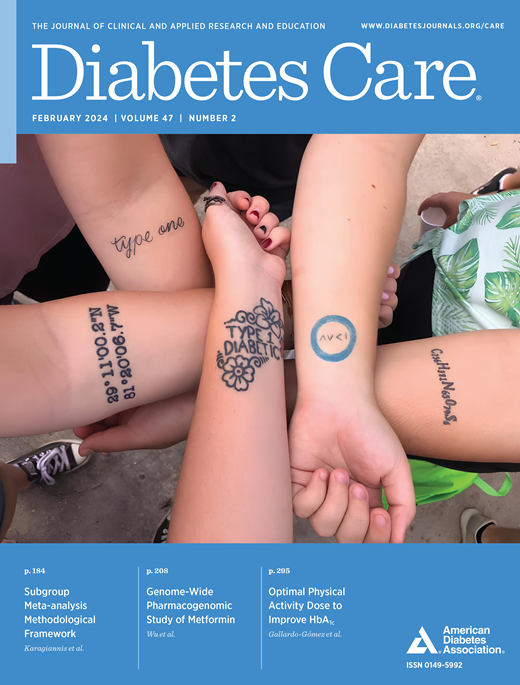The Efficacy and Safety of Glucagon-Like Peptide-1 Agonists in a Retrospective Study of Patients With Familial Partial Lipodystrophy
IF 16.6
1区 医学
Q1 ENDOCRINOLOGY & METABOLISM
引用次数: 0
Abstract
OBJECTIVE Glucagon-like peptide-1 receptor agonists (GLP-1RAs) are widely used for the management of diabetes mellitus (DM), but their efficacy in familial partial lipodystrophy (FPLD) is unknown. In this retrospective study, we evaluated the effect of GLP-1RA in patients with FPLD. RESEARCH DESIGN AND METHODS We analyzed data, reported with SDs, from 14 patients with FPLD (aged 58 ± 12 years; 76.47% female) and 14 patients with type 2 DM (aged 58 ± 13 years; 71% female) before and 6 months after starting GLP-1RA. RESULTS We observed reduction in weight (95 ± 23 to 91 ± 22 kg; P = 0.002), BMI (33 ± 6 to 31 ± 6 kg/m2; P = 0.001), HbA1c (8.2% ± 1.4% to 7.7% ± 1.4%; P = 0.02), and fasting glucose (186 ± 64 to 166 ± 53 mg/dL; P = 0.04) in patients with FPLD. The change in triglycerides after treatment was greater in the FPLD group compared with the DM group (P = 0.02). We noted acute pancreatitis in two cases with FPLD with longer therapy. CONCLUSIONS Our study demonstrates the relative safety and effectiveness of GLP-1RA in patients with FPLD.家族性部分脂肪营养不良患者回顾性研究中胰高血糖素样肽-1 激动剂的有效性和安全性
目的 胰高血糖素样肽-1受体激动剂(GLP-1RA)被广泛用于糖尿病(DM)的治疗,但其对家族性部分脂肪营养不良症(FPLD)的疗效尚不清楚。在这项回顾性研究中,我们评估了 GLP-1RA 对 FPLD 患者的疗效。研究设计和方法 我们分析了 14 名 FPLD 患者(年龄为 58 ± 12 岁;76.47% 为女性)和 14 名 2 型糖尿病患者(年龄为 58 ± 13 岁;71% 为女性)在开始服用 GLP-1RA 前和服用 6 个月后的数据(含标清)。结果 我们观察到,FPLD 患者的体重(95 ± 23 kg 至 91 ± 22 kg;P = 0.002)、BMI(33 ± 6 kg/m2 至 31 ± 6 kg/m2;P = 0.001)、HbA1c(8.2% ± 1.4% 至 7.7% ± 1.4%;P = 0.02)和空腹血糖(186 ± 64 至 166 ± 53 mg/dL;P = 0.04)均有所下降。与 DM 组相比,FPLD 组治疗后甘油三酯的变化更大(P = 0.02)。我们注意到,2 例 FPLD 患者在接受较长时间治疗后出现急性胰腺炎。结论 我们的研究表明,GLP-1RA 对 FPLD 患者具有相对的安全性和有效性。
本文章由计算机程序翻译,如有差异,请以英文原文为准。
求助全文
约1分钟内获得全文
求助全文
来源期刊

Diabetes Care
医学-内分泌学与代谢
CiteScore
27.80
自引率
4.90%
发文量
449
审稿时长
1 months
期刊介绍:
The journal's overarching mission can be captured by the simple word "Care," reflecting its commitment to enhancing patient well-being. Diabetes Care aims to support better patient care by addressing the comprehensive needs of healthcare professionals dedicated to managing diabetes.
Diabetes Care serves as a valuable resource for healthcare practitioners, aiming to advance knowledge, foster research, and improve diabetes management. The journal publishes original research across various categories, including Clinical Care, Education, Nutrition, Psychosocial Research, Epidemiology, Health Services Research, Emerging Treatments and Technologies, Pathophysiology, Complications, and Cardiovascular and Metabolic Risk. Additionally, Diabetes Care features ADA statements, consensus reports, review articles, letters to the editor, and health/medical news, appealing to a diverse audience of physicians, researchers, psychologists, educators, and other healthcare professionals.
 求助内容:
求助内容: 应助结果提醒方式:
应助结果提醒方式:


